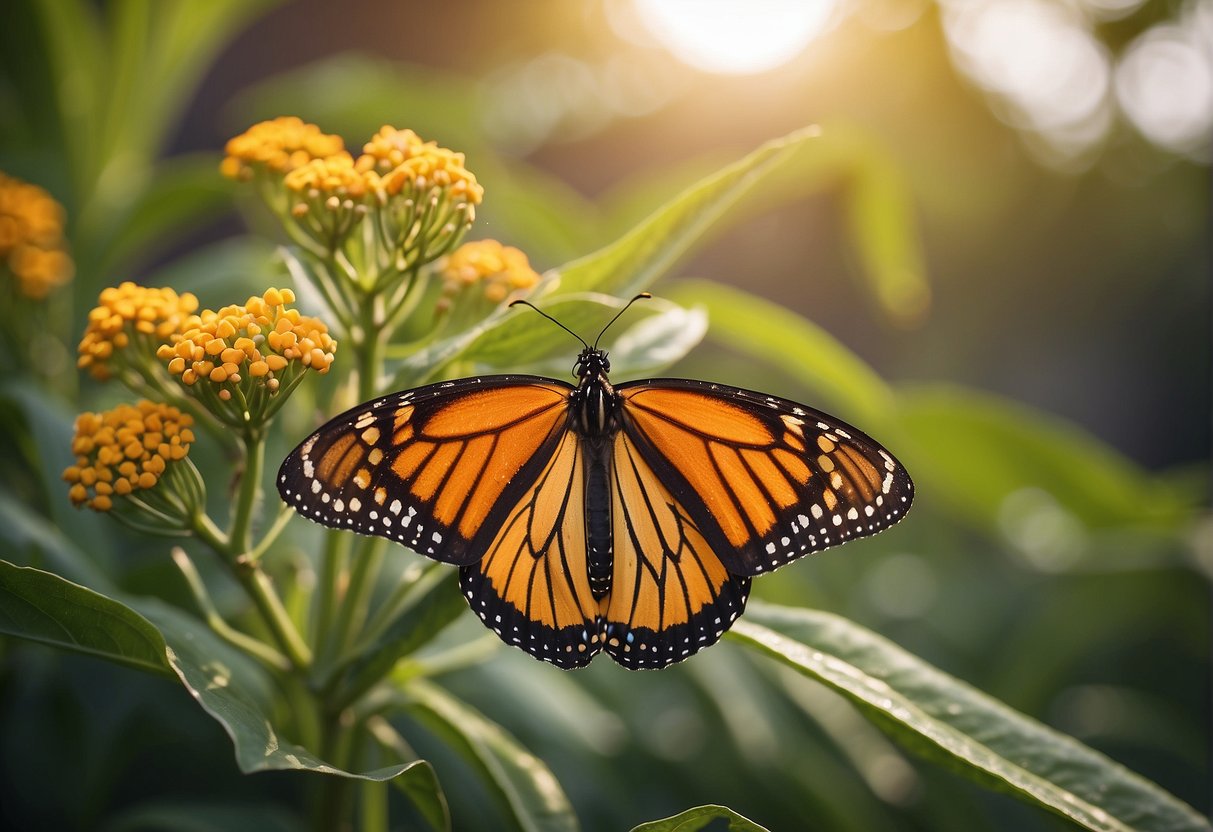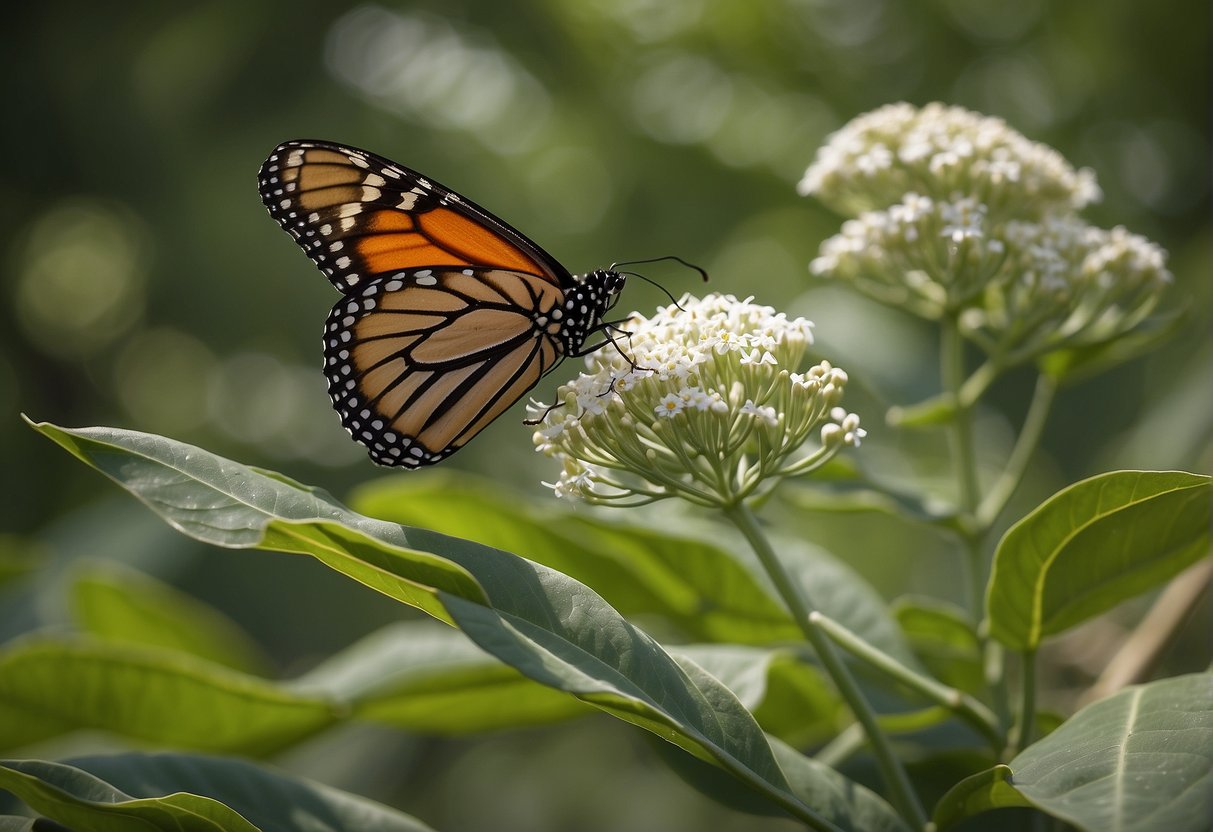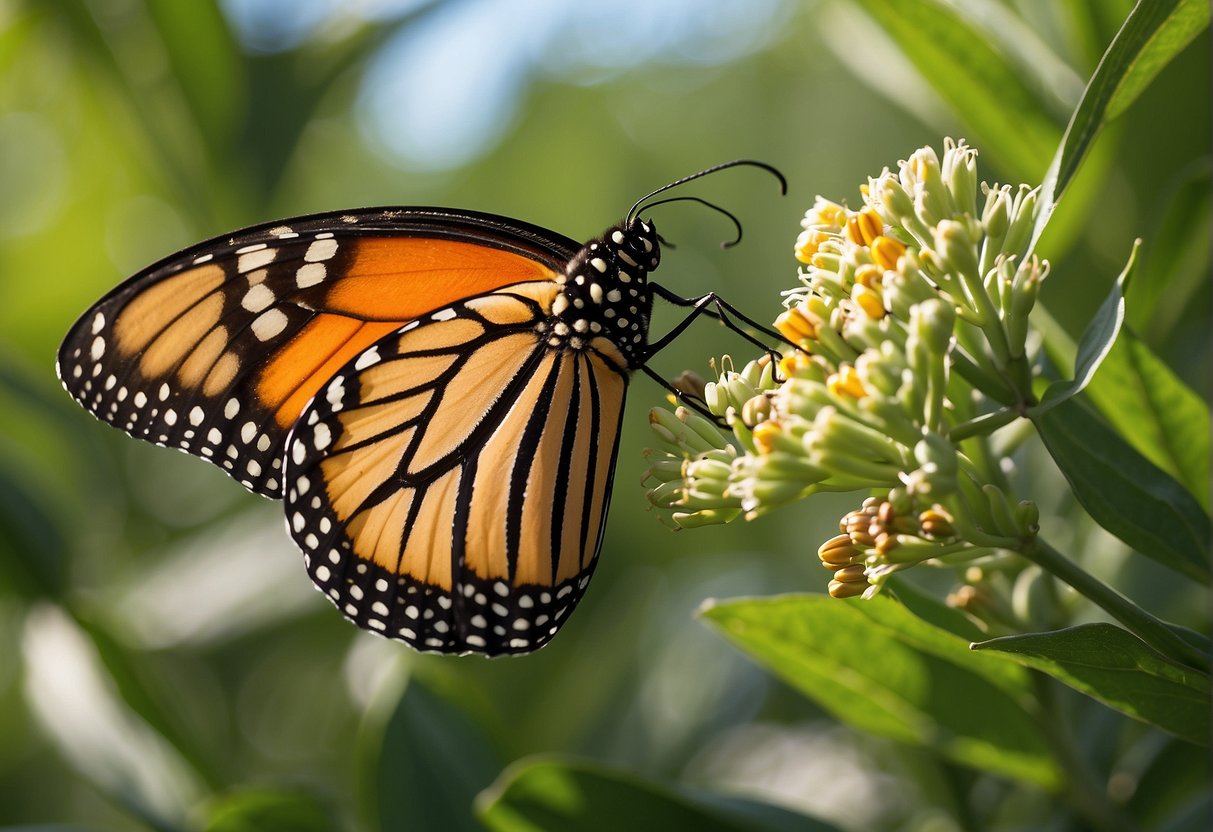What is the Relationship Between a Monarch Butterfly and Milkweed?
Have you ever had the chance to observe a monarch butterfly? Their striking orange and black wings are quite memorable. However, are you aware that monarchs share a unique bond with milkweed? This plant is crucial for the butterflies’ survival. In this article, we delve into the intricate connection between monarch butterflies and milkweed, highlighting its significance.

Monarch Butterfly and Milkweed Basics
Monarch butterflies are famous for their long migrations and unique life cycle. Milkweed is a crucial part of that life cycle. Monarchs lay their eggs on milkweed plants, and the caterpillars that hatch feed exclusively on milkweed leaves. Without milkweed, monarchs would not be able to complete their life cycle and would eventually die out. But milkweed is not just important for monarchs; it also provides important habitat for other insects and animals. In the next section, we’ll explore the life cycle and reproduction of monarchs in more detail.
Key Takeaways
- Milkweed is essential to the survival of monarch butterflies.
- Monarchs lay their eggs on milkweed plants, and the caterpillars that hatch feed exclusively on milkweed leaves.
- Milkweed also provides important habitat for other insects and animals.
Monarch Butterfly and Milkweed Basics
Biology of Monarch Butterflies
Monarch butterflies (Danaus plexippus) are a well-known species of butterfly that are recognized for their bold orange and black coloring. These butterflies are found throughout North America and are known for their long migrations, which can span thousands of miles. Monarch butterflies are also known for their unique life cycle, which includes four distinct stages: egg, larva, pupa, and adult.
During their larval stage, monarch butterflies feed almost exclusively on milkweed plants. This is because milkweed contains toxins that protect the monarchs from predators. The toxins are stored in the butterfly’s body, making them unpalatable to predators such as birds.
Understanding Milkweed
Milkweed (Asclepias) is a genus of plants that is known for its milky sap and distinctive flowers. There are over 100 species of milkweed, many of which are native to North America. Common milkweed (Asclepias syriaca) is one of the most well-known species of milkweed and is often used by monarch butterflies as a host plant for their eggs.
Milkweed is an important plant for many reasons. In addition to being a food source for monarch butterflies, milkweed also provides habitat for a variety of other insects and animals. The plant’s nectar-rich flowers are also an important food source for bees and other pollinators.
It is important to note that while milkweed is an important plant, it can also be toxic to some animals. Humans and livestock should avoid ingesting milkweed as it contains cardiac glycosides, which can be harmful if consumed in large quantities.
Overall, the relationship between monarch butterflies and milkweed is a fascinating one. Milkweed provides an important food source and habitat for monarch butterflies, while the butterflies help to pollinate the plant and protect it from herbivores.
Lifecycle and Reproduction

Egg Laying and Hatching
The monarch butterfly’s lifecycle begins when a female monarch lays her eggs on the underside of a milkweed leaf. The eggs are typically laid in clusters of 20-30 and are about the size of a pinhead. It takes about 3-5 days for the eggs to hatch into tiny caterpillars.
Caterpillar Growth
Once hatched, the caterpillars begin to feed on the milkweed leaves. Monarch caterpillars are voracious eaters and can consume up to 200 times their body weight in milkweed during their growth period. As they grow, the caterpillars molt their skin several times until they reach their full size of about 2 inches.
Chrysalis to Butterfly
After about 2 weeks of feeding and growing, the caterpillar will find a suitable spot to attach itself and form a chrysalis. Inside the chrysalis, the caterpillar undergoes metamorphosis and transforms into a butterfly. It takes about 10-14 days for the butterfly to fully develop and emerge from the chrysalis.
Throughout the entire lifecycle, milkweed plays a critical role in the survival of the monarch butterfly. The female monarch butterfly relies on milkweed as the sole host plant for laying her eggs, and the caterpillars rely on milkweed as their sole source of food. Without milkweed, the monarch butterfly would not be able to complete its lifecycle and would eventually become extinct.
Milkweed as a Host Plant

As you may know, monarch butterflies depend on milkweed plants for their survival. Milkweed is the only host plant that monarch butterflies lay their eggs on, and it plays a critical role in the monarch butterfly’s life cycle. In this section, we will explore the importance of milkweed as a host plant.
Feeding and Nutrition
Milkweed is not only the monarch butterfly’s host plant, but it also provides the caterpillar with all the nutrients it needs to develop into a butterfly. The leaves of milkweed plants are rich in protein, which is essential for the growth and development of the caterpillar. The caterpillar feeds on the leaves of the milkweed plant and grows rapidly, shedding its skin several times as it grows.
Toxic Defense Mechanisms
Milkweed is also a toxic plant, containing a group of chemicals known as cardiac glycosides. These chemicals are toxic to most animals, including humans, but the monarch butterfly has evolved to use them to its advantage. The caterpillar stores the cardiac glycosides in its body, making it toxic to predators. The bright colors of the caterpillar serve as a warning to predators that it is toxic and not to be eaten.
In conclusion, milkweed plays a crucial role in the survival of the monarch butterfly. As the only host plant for the butterfly, it provides the caterpillar with all the nutrients it needs to grow and develop into a butterfly. Additionally, the toxic defense mechanisms of the milkweed plant protect the caterpillar from predators, allowing it to complete its life cycle and become a beautiful butterfly.
Migration Patterns
The migration of monarch butterflies is one of the most fascinating phenomena in the natural world. These delicate creatures travel thousands of miles every year, from their breeding grounds in North America to their wintering sites in Mexico. The journey is long and arduous, and it requires the butterflies to rely on a single plant species: milkweed.
Journey to Mexico
Every fall, millions of monarch butterflies begin their journey to Mexico. They fly south from their breeding grounds in the United States and Canada, following the warm weather and the availability of milkweed plants. The butterflies fly in large groups, known as “supercolonies,” and they can travel up to 50 miles a day.
Overwintering Behavior
Once the monarch butterflies arrive in Mexico, they cluster together in the oyamel fir forests of the Sierra Madre Mountains. The butterflies form dense clusters on the branches of the trees, where they spend the winter months. The trees provide shelter from the cold weather, and the butterflies rely on their fat reserves to survive until spring.
Return to North America
In the spring, the monarch butterflies begin their journey back to North America. They fly northward, following the availability of milkweed plants. The butterflies mate and lay their eggs along the way, and the next generation of monarch butterflies continues the journey northward. The monarchs that reach the northern breeding grounds are the great-great-grandchildren of the butterflies that left the previous fall.
Overall, the migration patterns of monarch butterflies are closely linked to the availability of milkweed plants. Without milkweed, the monarchs would not be able to complete their journey, and their populations would decline.
Conservation and Challenges
Population Decline
The monarch butterfly population has been declining over the years, and this is a cause for concern. The decline is attributed to various factors, including habitat loss, climate change, and the use of pesticides. According to the Xerces Society, the population of monarch butterflies has declined by over 80% in the past two decades. This decline has resulted in the monarch butterfly being classified as an endangered species.
Habitat Loss and Urbanization
Habitat loss is one of the primary factors contributing to the decline of the monarch butterfly population. Milkweed, which is the primary food source for monarch butterflies, is being destroyed due to urbanization, agriculture, and other land-use changes. As a result, monarch butterflies are losing their breeding and feeding grounds, which is leading to a decline in their population.
Urbanization is one of the main contributors to habitat loss. As cities grow, natural habitats are destroyed, leaving little room for wildlife. This loss of habitat is particularly damaging to monarch butterflies, which rely on milkweed plants for their survival.
Climate Change Impact
Climate change is another factor contributing to the decline of the monarch butterfly population. Changes in weather patterns and temperatures are affecting the migration patterns of monarch butterflies. Warmer temperatures are causing milkweed plants to bloom earlier, which is disrupting the timing of the monarch butterfly’s migration. This disruption is causing the monarch butterfly population to decline.
The Endangered Species Act has been instrumental in the conservation of the monarch butterfly. The act provides protection to endangered species, including the monarch butterfly. However, more needs to be done to protect the monarch butterfly and its habitat. Conservation efforts should focus on protecting and restoring milkweed habitats, reducing the use of pesticides, and promoting sustainable land-use practices. By taking these steps, we can help to ensure the survival of the monarch butterfly for future generations.
Human Influence and Protection Efforts
Gardening with Milkweed
Planting milkweed in your garden is a great way to support monarch butterflies. Milkweed is the only plant that monarch caterpillars eat, and it also provides nectar for adult butterflies. When choosing milkweed for your garden, it’s important to select native species that are adapted to your region. This will help ensure that the milkweed is well-suited to the local climate and soil conditions, which will in turn help it thrive.
Creating Pollinator Gardens
In addition to planting milkweed, you can also create a pollinator garden that provides food and habitat for a wide range of pollinators, including monarchs. Pollinator gardens should include a variety of flowering plants that bloom at different times throughout the growing season. This will help ensure that there is a continuous source of nectar and pollen for the butterflies and other pollinators.
Conservation Initiatives
Conservation initiatives are also important for protecting monarchs and their habitat. These efforts may include habitat restoration projects, captive breeding programs, and public education campaigns. Some organizations also work to reduce the use of pesticides and herbicides, which can be harmful to monarchs and other pollinators.
By taking action to support monarch butterflies and their habitat, you can help ensure that these beautiful insects continue to thrive for generations to come. Whether you’re planting milkweed in your garden, creating a pollinator garden, or supporting conservation initiatives, every effort counts.
Interactions with Other Species
Predators and Parasites
As a monarch butterfly, you face a wide range of predators and parasites throughout your life cycle. For instance, during your larval stage, you may encounter predators such as birds, spiders, and wasps that feed on your milkweed leaves. Additionally, parasitoid wasps and flies may lay their eggs on your body, leading to your eventual demise.
As an adult, you are also at risk of predation by birds, spiders, and other insects. However, you have developed a few strategies to reduce your odds of being eaten. For example, your bright orange and black coloration warns predators that you are toxic due to the milkweed toxins you consumed as a caterpillar. Additionally, you can fly quickly and erratically to evade predators.
Beneficial Pollinators
While you may face many predators and parasites, you also have some beneficial interactions with other species. One of the most important interactions you have is with pollinators, such as bees and other butterflies. As you feed on nectar from flowers, you inadvertently transfer pollen from one flower to another, helping to fertilize the plant and ensure its survival.
In turn, the plants you visit provide you with a source of food and energy. For example, milkweed flowers provide you with nectar, which is rich in carbohydrates, and pollen, which contains essential nutrients such as protein and fats. Without these food sources, you would not be able to complete your life cycle and reproduce.
Overall, your interactions with other species are complex and varied. While you face many challenges from predators and parasites, you also have important relationships with pollinators that help to ensure your survival and the survival of the plants you depend on.
Scientific Research and Studies
Coevolution of Monarch and Milkweed
The relationship between Monarch butterflies and milkweed plants is a classic example of coevolution. Scientists have found that Monarchs have evolved to be dependent on milkweed plants for their survival. Milkweed plants contain toxic chemicals called cardenolides, which are poisonous to most animals. However, Monarchs have evolved to be able to tolerate these chemicals and even use them to their advantage. The caterpillars of Monarchs feed exclusively on milkweed leaves, which makes them toxic to predators.
In turn, milkweed plants have also evolved to benefit from the presence of Monarchs. The plants produce a sticky, milky sap that is toxic to most insects, but Monarch caterpillars are able to feed on it without harm. Additionally, Monarch butterflies are important pollinators for milkweed plants, helping to ensure their continued survival.
Monitoring Monarch Populations
Scientists have been monitoring Monarch butterfly populations for decades in order to better understand their behavior and help protect them from threats such as habitat loss and climate change. One important tool used by scientists is citizen science, where members of the public are trained to collect data on Monarch populations and report their findings.
Through these monitoring efforts, scientists have been able to track changes in Monarch populations over time and identify areas where conservation efforts are needed. For example, in recent years, Monarch populations have declined due to loss of habitat and other factors. By monitoring these populations, scientists can work to protect Monarchs and ensure their continued survival.
Overall, scientific research and studies have helped us to better understand the relationship between Monarch butterflies and milkweed plants. By continuing to study these fascinating creatures, we can work to protect them and ensure that they continue to thrive for generations to come.
Frequently Asked Questions
Why do monarch butterflies rely on milkweed plants?
Monarch butterflies rely on milkweed plants as their sole food source during their larval stage. The leaves of milkweed plants contain toxins that are poisonous to most animals, but monarch caterpillars have evolved to be able to eat them and store the toxins in their bodies, making them unpalatable to predators.
How does milkweed benefit from the presence of monarch butterflies?
Milkweed plants benefit from the presence of monarch butterflies because they are the only pollinators that can transfer pollen from one milkweed plant to another. As monarch butterflies feed on the nectar of milkweed flowers, they inadvertently transfer pollen from the male to the female parts of the flowers, allowing for fertilization and the production of seeds.
What are the consequences of monarch caterpillars consuming milkweed?
Monarch caterpillars consume large amounts of milkweed leaves during their development, which can have negative effects on the milkweed plant. However, this consumption also stimulates the plant to produce new leaves and stems, which can lead to increased growth and reproduction.
Can milkweed toxicity affect the survival of monarch butterflies?
Milkweed toxicity can affect the survival of monarch butterflies if they consume too much of the plant’s toxins. However, monarch caterpillars have evolved to be able to tolerate these toxins and even use them as a defense mechanism against predators.
What role does milkweed play in the lifecycle of monarch butterflies?
Milkweed plays a crucial role in the lifecycle of monarch butterflies as the sole food source for their larvae. Monarch butterflies lay their eggs on milkweed plants, and once the eggs hatch, the caterpillars feed on the milkweed leaves until they are ready to pupate and eventually emerge as adult butterflies.
How does the interaction between monarch butterflies and milkweed exemplify mutualism?
The interaction between monarch butterflies and milkweed exemplifies mutualism because both species benefit from the relationship. Monarch butterflies rely on milkweed as their food source and milkweed benefits from the pollination services provided by the butterflies. This mutually beneficial relationship is essential for the survival of both species.


